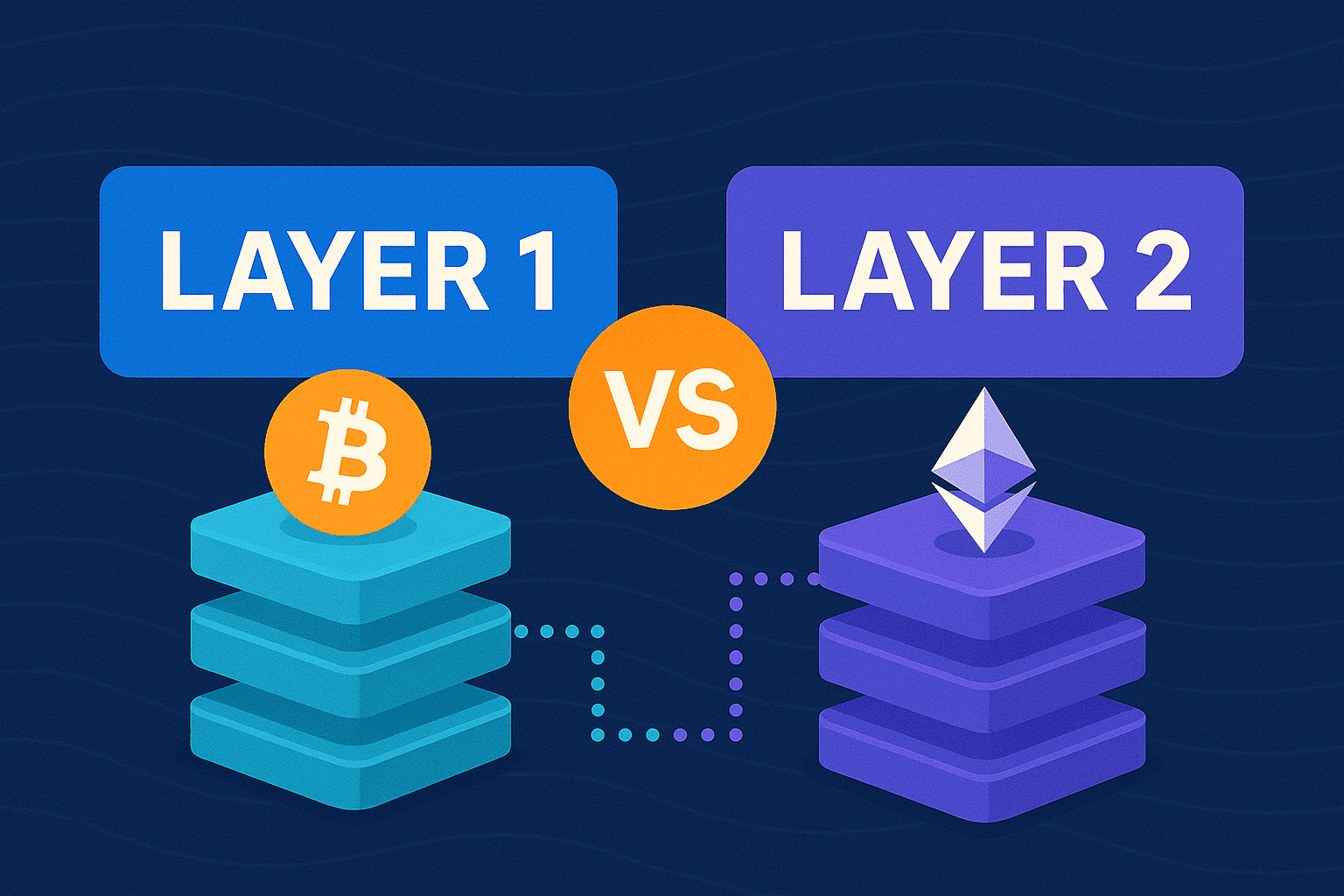Understanding the difference between Layer 1 and Layer 2 protocols is key in today’s blockchain landscape. Layer 1 is the base chain responsible for security and consensus, while Layer 2 are scaling solutions built on top to handle transactions faster and cheaper. In this article, we’ll explore both layers’ architectures, benefits and drawbacks, real-world examples, enterprise use cases, and future outlook.
1. Layer 1: The Blockchain Base Layer
1.1 Architecture & Consensus
Layer 1 (L1) is the main blockchain with its own consensus mechanism (Proof of Work, Proof of Stake, etc.). It handles:
- Recording and storing all transactions in a single chain.
- Verifying correctness through network consensus.
- Ensuring data security and resistance to 51% attacks.
1.2 Examples of Layer 1
- Bitcoin: PoW, 10-minute blocks, ≈7 TPS.
- Ethereum: PoS after The Merge, ≈12-second blocks, 15–30 TPS.
- Solana: PoH + PoS, ≈400 ms blocks, 2 000–5 000 TPS.
- Cardano: Ouroboros PoS, ≈20-second blocks, 250–1 000 TPS.
1.3 Pros & Cons of Layer 1
| Criterion | Pros | Cons |
|---|---|---|
| Security | High via native consensus | Depends on decentralization of hashpower or stake |
| Decentralization | Many nodes | Slow protocol upgrades |
| Scalability | Stable operation | Low throughput, high fees |
2. Layer 2: Scaling Solutions
2.1 Concept & Goals
Layer 2 (L2) refers to solutions running atop L1 that process most transactions off-chain, posting only summarized data back to L1. Their objectives:
- Boost throughput into hundreds or thousands of TPS.
- Reduce costs for users.
- Maintain security via L1 anchoring.
2.2 Main Types of Layer 2
- State channels: off-chain payment or contract channels (Lightning, Raiden).
- Rollups: batch transactions and commit proofs on-chain.
- Optimistic Rollups (Arbitrum, Optimism): rely on fraud proofs.
- zk-Rollups (zkSync, StarkNet): use cryptographic proofs for instant verification.
- Sidechains: separate chains with their own consensus bridged to L1 (Polygon PoS, xDai).
- Plasma & Validium: rollup-like designs with off-chain data storage.
2.3 Comparing L2 Mechanisms
| Mechanism | TPS | Fees | Security |
|---|---|---|---|
| State channels | up to 10 000 | minimal | trust among participants |
| Optimistic Rollups | up to 2 000 | low | fraud proofs |
| zk-Rollups | 500–5 000 | very low | cryptographic proofs |
| Sidechains | 300–1 500 | medium | varies by security model |
3. UX & Cross-Layer Integration
3.1 Bridges
Moving assets between L1 and L2 uses bridges:
- Smart contracts lock/unlock assets.
- Proofs are relayed between networks.
- Risks include bugs, exploits, and finality delays.
3.2 User Experience
- Users must wait for L1 confirmations before opening channels.
- Specialized wallets (Lightning, zkSync) streamline L2 use.
- Best practice: unified UX with automatic bridging.
4. Development & Tooling
4.1 SDKs & Libraries
- Ethereum L2: @arbitrum/sdk, optimistic-provider.
- zk-Rollups: zkSync SDK, StarkNet JS.
- State channels: Lightning-dev, Raiden-SDK.
4.2 Smart Contract Patterns
Developers must handle:
- Gas abstraction and fee payment on L2.
- Cross-chain message handling.
- Security checks against L1 finality.
5. Enterprise Use Cases
5.1 Financial Sector
Lightning enables instant micropayments between banks; zk-Rollups support confidential DeFi settlements.
5.2 Supply Chains
Polygon PoS sidechain integrates ERP and traceability with high throughput.
5.3 Gaming & NFTs
Solana L2 and state channels power instant in-game asset purchases.
6. Security & Audits
6.1 L2 Threats
- Ensuring fraud proofs and zk proofs operate correctly.
- Bridge vulnerabilities: MEV, time-delay exploits.
6.2 Audits
- ConsenSys Diligence for optimistic rollups.
- StarkWare audits for zk-Rollups.
- Trail of Bits for state channels.
7. Fee Economics
7.1 Payment Models
L1 fees vary with network load; L2 fees are fixed or negligible.
7.2 Validator ROI
Validation costs vs. throughput: state channels incur minimal costs; rollups pay L1 gas fees.
8. Interoperability & Future Trends
8.1 Layer0 Standards
- LayerZero, Chainlink CCIP for cross-chain messaging.
- IBC in Cosmos for standardized interchain communication.
8.2 Layer 3 & Modular Blockchains
Emerging L3 “application” layers address privacy, AI data, NFT marketplaces, etc.
9. Practical Recommendations
9.1 For Users
- Frequent micro-payments → state channels.
- DeFi/dApp on EVM → optimistic rollups.
- Confidential transactions → zk-Rollups.
9.2 For Businesses
- Enterprise chains → sidechains or private state channels.
- High throughput → Solana L2 or zkEVM solutions.
10. Conclusion
Layer 1 and Layer 2 together form an ecosystem where L1 ensures security and decentralization, and L2 delivers scalability and low fees. Choosing the right layer depends on goals: instant micropayments, complex DeFi protocols, or enterprise integration. Knowing their trade-offs helps optimize cost, speed, and security.





















